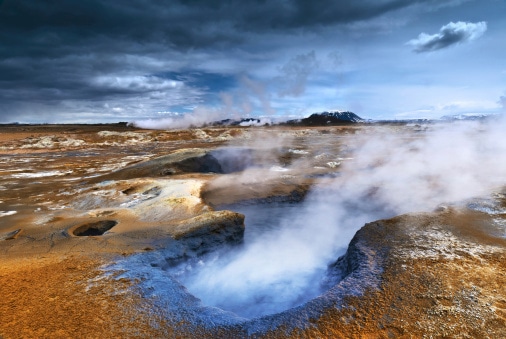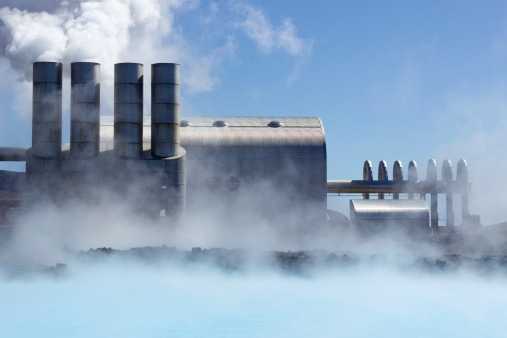Geothermal energy is the heat obtained from the ground. This energy originates from the radioactive decay of minerals and the original formation of the planet. The utilization of geothermal energy dates back to ancient humans, who would bathe in hot springs heated by the Earth's inert heat under the magma chambers.
Geothermal energy is continuously conducted in the form of heat through the geothermal gradient, which is the temperature difference between the planet core and its surface. Geothermal energy is inexpensive, eco-friendly, sustainable and reliable, but limited to the areas of tectonic plate boundaries.
Geothermal wells emit greenhouse gases that are trapped within the earth. However, these emissions are very low per energy unit than those released by fossil fuels therefore, geothermal energy has the potential to mitigate global warming.
Geothermal power plants are installed in nearly 24 countries worldwide and they produce about 10,715 MW of energy. Although the Earth's geothermal resources are available in large quantities to meet the supply of our own energy needs, drilling and the exploration for deep resources can be highly expensive.
Studies show that the future of geothermal energy depends on the subsidies, interest rates and energy prices. However, the cost of producing geothermal power has decreased by 25% over the last two decades owing to the industrial experience and government-assisted research.

Hot springs such as this gave way to the collection and distribution of Geothermal energy through power plants. Image Credits: Photos.com
Types of Geothermal Power Plant
There are four types of geothermal power plants being commercially used which include the following:
Dry Steam Plants – This plant uses very hot steam and a small amount of water from the geothermal reservoir. The steam is passed directly to a turbine through a pipe to rotate a generator for producing electricity. It is the oldest type of power plant and was first used at Lardarello, Italy, in 1904.
Flash Steam Plants – This plant employs high pressure hot water for producing steam. The hot water pumped into the generator is released from the pressure of the reservoir. The pressure drops causing water to vaporize enabling the turbines to spin which generates electricity. Both flash steam and dry steam power plants release small amounts of sulfur, nitric oxide and carbon dioxide, whcih by comparison is slightly less than other fossil-fuel power plants. Hot water that is not vaporized is returned to the reservoir via injection wells.
Binary Cycle Plants – This plant uses moderate-temperature water from the reservoir. Hot geothermal fluids are passed from one side of a heat exchanger for heating a working fluid in a separate pipe. The working fluid is then vaporized and passed via a turbine for generating electricity. The working fluid can either be isobutene or other organic fluids like pentafluoropropane.
Flash/Binary Combined Cycle – This plant combines binary and flash technologies. Geothermal water is vaporized into steam under reduced pressure which is converted into electricity. The low-pressure steam exits a backpressure turbine and is condensed in a binary system.
 A typical geothermal power plant. Image Credits: Photos.com
A typical geothermal power plant. Image Credits: Photos.comBenefits of Geothermal Energy
The key benefits of geothermal power are:
- It is a non-polluting, renewable source of energy.
- Geothermal power plants provide steady baseload power.
- Direct use of geothermal energy can save as much as 80% in comparison with other conventional fuel costs.
- Properly managed geothermal resources can generate energy for a long time.
- As geothermal energy is produced from domestic resources, it reduces the dependence on imported energy.
- A small amount of pollutant emissions is produced from geothermal plants when compared to other traditional fossil fuel power plants.
- Geothermal plants occupy less space.
- Maintenance costs of these plants are inexpensive.
- During production, there is no wastage or by-product generation.
Applications of Geothermal Energy
Some of the major applications of geothermal energy include:
- Power generation – It is a promising technology that has been successful in places that highly depends on imported fossil fuels.
- Industrial processes – The geothermal heat can be used for digesting paper, wood pulp and drying timber.
- Geothermal prawn farming – The world’s first geothermally heated prawn farm was developed on Waikato River banks. The farm heats its own water using heat exchangers that make use of heat from power station’s waste water. Cascading also reduces hot water discharge into the river to avoid any harm to aquatic life.
- Horticulture - Geothermal waters are widely being used to heat small-scale greenhouses for producing vegetables, flowers and fruits that are out-of-season.
- District and space heating - District systems circulates hydrothermal water from geothermal wells to individual houses and buildings via a series of pipes. Space heating employs one well per structure. Geothermal district heating systems has the potential to save 30% to 50% of the cost of natural gas heating.
Sources and Further Reading